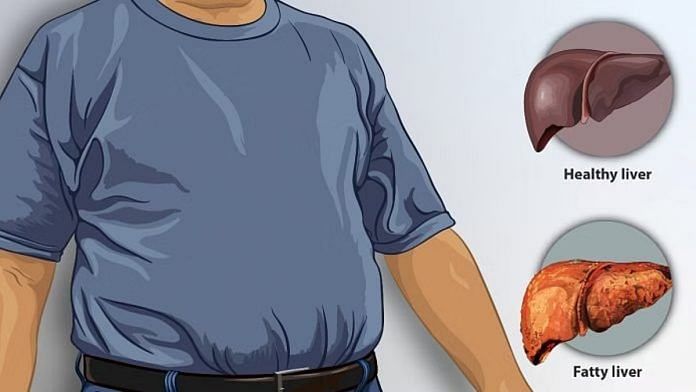New Delhi: The Centre Friday came out with new guidelines and a training manual on managing cases of Non-Alcoholic Fatty Liver Disease (NAFLD), the prevalence of which is rising alarmingly in the country. The new measures put greater focus on lifestyle modifications and early interventions to diagnose and treat the chronic condition.
The guidelines have been released as part of the National Programme for Prevention and Control of Cancer, Diabetes, Cardiovascular Diseases and Stroke (NPCDCS), as NAFLD is closely associated with obesity, type 2 diabetes mellitus, dyslipidemia or high cholesterol, hypertension, coronary artery disease and several cancers.
NAFLD is the most common chronic liver disease globally, estimated to affect up to a third of adults worldwide. In India, the estimated prevalence ranges from 9 to 53 percent, according to the Union health ministry’s latest estimates. Previous estimates from 2021 had suggested its prevalence to be between 9 and 32 percent in India.
This liver disorder is caused by the accumulation of excess fat in liver cells, not necessarily caused by significant alcohol consumption, as was the case till some decades ago. And while it is normal for the liver to contain some fat, if it constitutes more than 5 percent of the organ’s weight, it is called a fatty liver or steatosis.
The disease encompasses a spectrum of conditions, ranging from simple fatty liver (NAFL or simple steatosis) to non-alcoholic steatohepatitis (NASH). In NAFL, hepatic steatosis is present without evidence of significant inflammation, whereas in NASH, hepatic steatosis is associated with hepatic inflammation.
In individuals with NASH, continued inflammation and liver cell damage can lead to liver fibrosis, characterised by the accumulation of scar tissue.
Over time, advanced fibrosis can progress to cirrhosis, a severe stage associated with liver dysfunction and complications such as liver failure and liver cancer. It has been estimated that 30-40 percent cases of liver cancers in India are due to NAFLD.
The new guidelines — prepared by a 13-member expert panel under the chairmanship of Director General of Health Services Dr Atul Goel and senior hepatologist Dr S K Sarin — say that as the condition predates many non-communicable diseases and has a bi-directional link with them, it requires a robust primary care component for prevention and control.
Sarin, who is director of the Delhi-based Institute of Liver and Biliary Sciences, said the move is a remarkable step and results will be reflected in the next few years.
The previous guidelines on NAFLD management were released in 2021.
Also Read: Diabetes drug semaglutide offers hope beyond obesity management — kidney, heart & liver health
Focus on early intervention, identifying who is more susceptible
Several factors contribute to the development of NAFLD, note the new guidelines, adding that understanding these risk factors helps identify individuals more susceptible to the disease and its progression.
Excess body weight, especially abdominal obesity, is a significant risk factor for NAFLD as the accumulation of fat around the abdomen contributes to insulin resistance and inflammation in the liver.
Also, the condition is frequently observed in individuals with metabolic syndrome (a group of health issues that together increase risk of heart disease, diabetes, stroke etc.), and has been observed in 60-90 percent of people who are obese. The new recommendations note that the disorder is also observed to occur in 40-80 percent of those with type 2 diabetes mellitus while lack of physical activity and a sedentary lifestyle are also associated with development and progression of the disease.
Middle-aged and older adult males are at higher risk, and certain medications (such as corticosteroids, tamoxifen), and some medical conditions have been classified among other risk factors.
For lean individuals with NAFLD, the guidelines recommend lifestyle modification with focus on maintaining current weight and adopting a nutrient-dense diet.
Key recommendations also include a balanced diet with complex carbohydrates, lean proteins, healthy fats, and reduced free sugars, incorporating millets and high-fiber foods, and ensuring adequate protein intake, especially in advanced stages like cirrhosis.
Also, according to the guidelines, regular physical activity, including at least 150 minutes of moderate-intensity aerobic exercise per week and strength training twice a week, is essential. They also advise minimising sedentary time and strictly avoiding alcohol to prevent further liver damage.
These modifications help manage NAFLD and prevent disease progression, supporting overall health and well-being, say the government recommendations.
Currently, according to the guidelines, there is no specific medication approved for NAFLD and pharmacological interventions for managing the disease are still under development.
Population-level screening
The latest guidelines have laid particular emphasis on screening beginning at the community level. For this, forms provided to Accredited Social Health Activists (ASHA) to screen people for several non-communicable diseases (NCDs) will also have indicators that suggest NAFLD.
The routine monitoring mechanism, which is being adopted for the National Programme on NCDs, will now also include the indicators for NAFLD.
Those identified as high-risk, like people with personal and family history of diabetes, hypertension, coronary heart disease, liver diseases, gallstones and cancers, or people with high waist circumference or body mass index will be referred to primary health centres or Ayushman Arogya Mandirs (formerly Ayushman Bharat-Health and Wellness Centres) for further assessment.
For medical officers working at sub centres, primary and community health centres and district hospitals, separate training modules are set to be organised for managing various stages of NAFLD.
“These measures are additions in the new guidelines and had not been adopted earlier despite NAFLD having been recognised as part of the NPNCD three years back,” a senior health ministry official told ThePrint.
(Edited by Gitanjali Das)
Also Read: Combination of 2 immunotherapy drugs can help liver cancer patients live longer, finds India study






